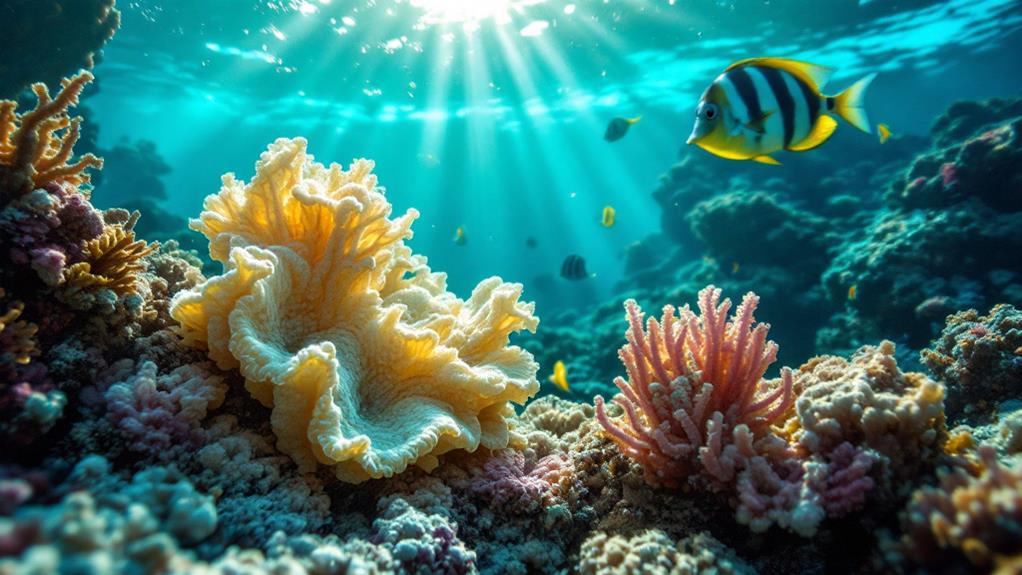Amazing Phenomena on Earth: Natural Wonders That Will Leave You in Awe
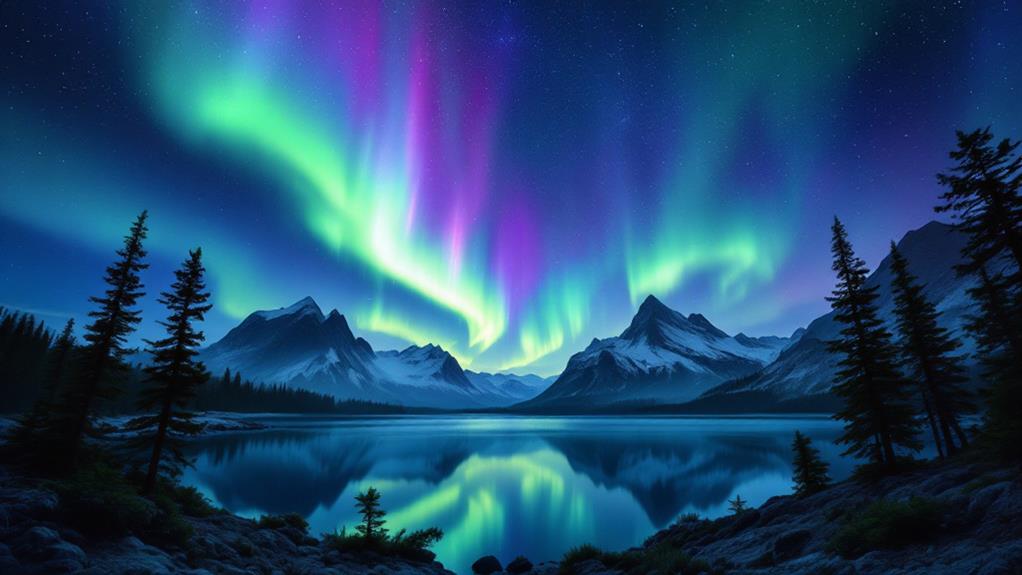
Earth's natural wonders will leave you spellbound. You'll marvel at the ethereal dance of the Northern Lights and the geometric precision of Giant's Causeway. The Great Barrier Reef's vibrant underwater world will astonish you, while Salar de Uyuni's mirror-like surface will challenge your perception. You'll feel like you're in a fantasy domain at Zhangjiajie National Forest Park, and the alien terrain of Dallol Volcano will transport you to another planet. From underwater cenotes to glowworm caves, our planet offers a breathtaking array of phenomena. These awe-inspiring sights are just the beginning of Earth's incredible natural treasures.
The Northern Lights
A shimmering curtain of light dances across the night sky, enchanting observers with its ethereal beauty. You're witnessing the Northern Lights, also known as Aurora Borealis, one of nature's most spectacular displays. This mesmerizing phenomenon occurs when charged particles from the sun collide with atoms in Earth's atmosphere, creating dancing light patterns that illuminate the polar regions.
As you gaze upward, you'll see colorful sky displays ranging from pale green to vivid pink, purple, and red. The lights can take various forms, from undulating ribbons to pulsating glows. To maximize your chances of seeing this natural wonder, you'll want to visit locations near the Arctic Circle during the darker months, typically from September to March.
While the Northern Lights are visible from several countries, popular viewing spots include Iceland, Norway, Finland, and parts of Canada and Alaska. For the best experience, seek out areas with minimal light pollution and clear skies. Remember, patience is key – the aurora's appearance can be unpredictable, but the wait is well worth it for this awe-inspiring celestial show.
Giant's Causeway
Northern Ireland's coastline hides a geological marvel that's both mystifying and awe-inspiring. The Giant's Causeway, a UNESCO World Heritage site, boasts over 40,000 interlocking basalt column formations. These hexagonal pillars, formed by volcanic activity 60 million years ago, create a surreal landscape that'll leave you speechless.
As you investigate this natural wonder, you'll witness the power of coastal erosion patterns that have shaped the area over millennia. The columns range in height, with some towering up to 39 feet, creating a stepping-stone-like pathway into the sea.
The Giant's Causeway evokes a range of emotions:
- Wonder at nature's geometric precision
- Awe at the sheer scale of the formation
- Curiosity about the legends surrounding its creation
- Humility in the face of Earth's ancient history
You'll find yourself enthralled by the interplay of light and shadow on the columns, especially during sunset. The site's unique geology attracts scientists and tourists alike, offering a glimpse into Earth's volcanic past and the ongoing processes that shape our planet's surface.
Great Barrier Reef

Stretching over 1,400 miles along Australia's northeast coast, the Great Barrier Reef is the world's largest coral reef system. This natural wonder is composed of over 2,900 individual reefs and 900 islands, making it visible from space. As you plunge into this underwater paradise, you'll be amazed by the vibrant colors and diverse marine life.
The Great Barrier Reef is home to an incredible array of marine biodiversity, including over 1,500 species of fish, 400 types of hard coral, and numerous other marine organisms. You'll encounter sea turtles gliding through crystal-clear waters, spot playful dolphins, and marvel at the majestic humpback whales during their annual migration.
Sadly, climate change and ocean acidification threaten this delicate ecosystem. Rising sea temperatures cause coral bleaching, while pollution and overfishing further damage the reefs. Conservation efforts are underway to protect this natural wonder, but it's essential that we all do our part to preserve the Great Barrier Reef for future generations to enjoy its unparalleled beauty and ecological significance.
Salar De Uyuni
From underwater marvels to otherworldly terrains, we shift our focus to Bolivia's Salar de Uyuni. This extraordinary landscape is the world's largest salt flat, spanning over 4,000 square miles. You'll find yourself standing on a vast, white expanse that stretches as far as the eye can see, creating an illusion of endless space.
During the rainy season, a thin layer of water transforms the salt flats into the world's largest mirror. This breathtaking phenomenon reflects the sky so perfectly that it's often impossible to distinguish where the earth ends and the heavens begin. You'll feel as if you're walking on clouds, surrounded by an infinite horizon.
The surreal beauty of Salar de Uyuni evokes a range of emotions:
- Awe at the sheer scale and otherworldly appearance
- Tranquility from the vast, uninterrupted landscape
- Introspection as you contemplate your place in the universe
- Joy in witnessing nature's ability to create such unique wonders
As you investigate this natural wonder, you'll encounter bizarre rock formations, colorful lagoons, and even flamingos that call this unusual habitat home. Salar de Uyuni truly is a documentation of Earth's capacity for creating awe-inspiring landscapes.
Zhangjiajie National Forest Park
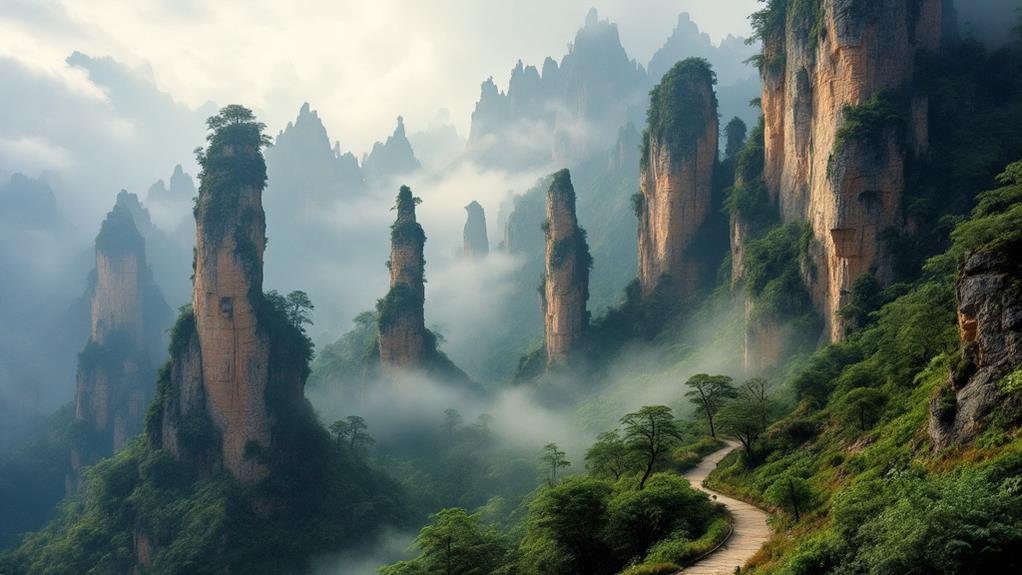
As you experience the park, you'll encounter over 3,000 of these colossal pillars, some reaching heights of over 1,000 feet. The mist that often shrouds the area adds to its mystical allure, making the peaks appear as if they're truly floating in the air. Don't miss the Tianmen Mountain, where you can walk on glass-bottomed pathways known as "crystal bridges," offering heart-stopping views of the valley below.
The park's diverse ecosystem is home to numerous rare plant and animal species. You'll have the chance to spot endangered creatures like the Chinese giant salamander and the clouded leopard. With its breathtaking scenery and rich biodiversity, Zhangjiajie National Forest Park offers an unforgettable experience that'll leave you in awe of nature's grandeur.
Underwater Cenotes
While Zhangjiajie's towering pillars inspire awe above ground, underwater cenotes offer a mesmerizing subterranean spectacle. These natural wonders, found primarily in Mexico's Yucatan Peninsula, are underwater sinkholes formed by collapsed limestone bedrock. As you descend into these crystal-clear pools, you'll be transported to an otherworldly realm of pristine beauty.
Cenote formations vary widely, from open-air caverns to fully enclosed underground chambers. Each cenote has its unique characteristics, shaped by millions of years of geological processes. As you explore these underwater marvels, you'll encounter:
- Ethereal light beams piercing through the water's surface
- Intricate rock formations and stunning stalactites
- Ancient Maya artifacts preserved in the depths
- Diverse marine life thriving in these isolated ecosystems
The experience of swimming or plunging into a cenote is truly unforgettable. You'll feel a sense of weightlessness as you glide through the crystal-clear waters, surrounded by the cave's natural architecture. The play of light and shadow creates an ever-changing underwater landscape, revealing hidden corners and mysterious passages. These underground oases not only offer a unique journey but also provide valuable insights into the region's geology and ancient history.
Dallol Volcano
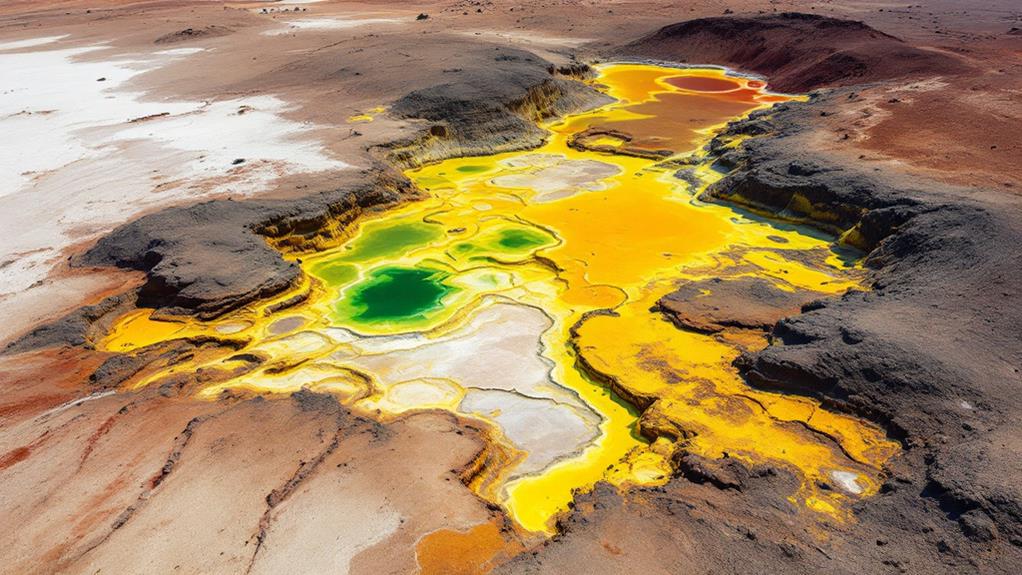
Amidst the harsh Danakil Desert in Ethiopia, you'll find one of Earth's most surreal terrains: the Dallol Volcano. This otherworldly landscape boasts unique geological features that'll make you question if you're still on Earth. As you investigate, you'll encounter a kaleidoscope of vibrant colors, from acid-yellow sulfur fields to deep red iron oxide pools.
Dallol's extreme environmental conditions set it apart from other volcanic regions. It's not only one of the hottest places on the planet, with temperatures regularly soaring above 100°F (38°C), but also one of the lowest, sitting 150 feet (45 meters) below sea level. You'll be amazed by the alien-like formations of salt pillars, mineral-rich hot springs, and bubbling acid ponds that dominate the area.
The volcano's hydrothermal activity creates a constantly changing landscape, where new features emerge and others disappear. As you traverse this hostile environment, you'll witness firsthand the raw power of Earth's geological processes, shaping a terrain that seems more suited to a distant planet than our own world.
Waitomo Glowworm Caves
From the scorching deserts of Ethiopia, we venture to the cool, subterranean world of New Zealand's Waitomo Glowworm Caves. You'll find yourself mesmerized by an otherworldly bioluminescence display as thousands of tiny glowworms illuminate the cave ceilings like a living starry sky.
As you glide silently through the caves on a boat, you'll witness nature's own light show. The glowworms, actually larvae of the fungus gnat, create this stunning spectacle to attract prey. But that's not all these caves have to offer. You'll also encounter unique cave formations, including stalactites and stalagmites that have taken millennia to form.
The Waitomo Glowworm Caves will leave you:
- Awestruck by the beauty of natural bioluminescence
- Humbled by the ancient geological processes at work
- Enchanted by the magical atmosphere of the underground world
- Inspired by the delicate balance of life in this unique ecosystem
Your passage through these caves isn't just a visual treat; it's a multi-sensory experience that'll stay with you long after you've returned to the surface. The Waitomo Glowworm Caves are a chronicle to nature's ability to create wonder in the most unexpected places.
Cappadocia's Fairy Chimneys
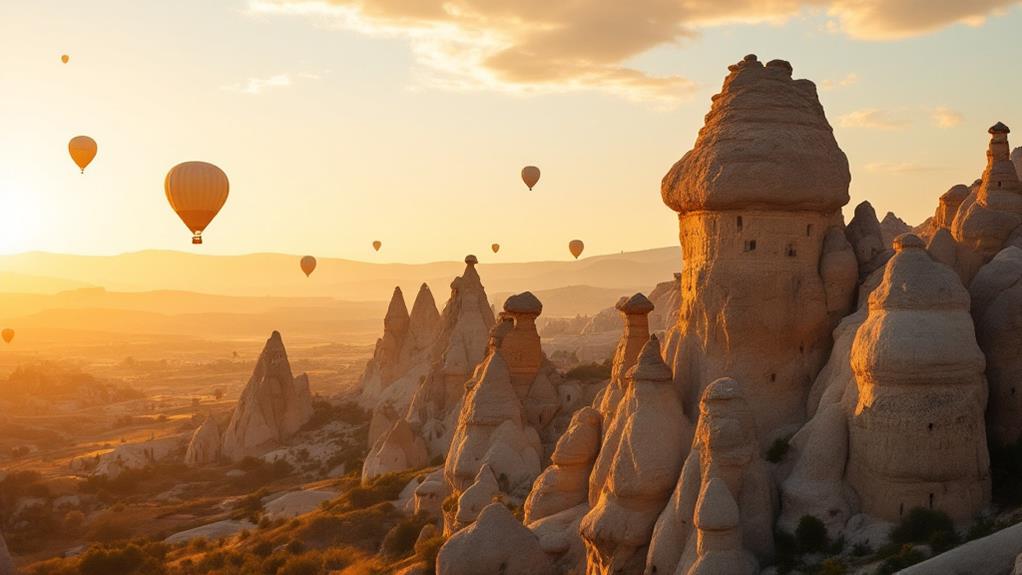
These cone-shaped spires, some reaching heights of 130 feet, were formed millions of years ago by volcanic eruptions and subsequent erosion. The soft volcanic rock, called tuff, was gradually sculpted by wind and water, leaving behind harder, more resistant caps atop slender pillars.
You'll be amazed by the variety of shapes these fairy chimneys take, from mushroom-like structures to towering cones. The region's early inhabitants carved homes, churches, and entire underground cities into these soft rock formations, creating a fascinating blend of natural and human-made wonders.
As you investigate Cappadocia, you'll uncover that the fairy chimneys aren't just a stunning background. They're an integral part of the area's history and culture, offering a glimpse into ancient civilizations and their ingenious use of the geographic setting. Don't miss the opportunity to take a hot air balloon ride for a breathtaking aerial view of this extraordinary geological marvel.
Socotra Island
Located off the coast of Yemen in the Arabian Sea, Socotra Island stands as one of the world's most unique and alien-looking terrains. This isolated ecosystem has evolved separately from the mainland for millions of years, resulting in an extraordinary landscape that'll make you feel like you've stepped onto another planet.
Socotra's endemic flora and fauna are what truly set it apart. You'll encounter bizarre-looking dragon blood trees, with their distinctive umbrella-shaped canopies, and bottle trees with their bulbous trunks. The island's isolation has led to the development of numerous plant and animal species found nowhere else on Earth.
As you immerse yourself in this otherworldly island, you'll:
- Marvel at the surreal environments that seem straight out of a science fiction movie
- Feel a sense of wonder at nature's ability to create such unique life forms
- Experience the thrill of unearthing a place untouched by modern civilization
- Gain a newfound appreciation for the importance of preserving isolated ecosystems
Socotra's pristine beaches, limestone caves, and towering sand dunes add to its allure. You'll find yourself constantly amazed by the island's diverse habitats and the resilience of its flora and fauna in this harsh, windswept environment.



